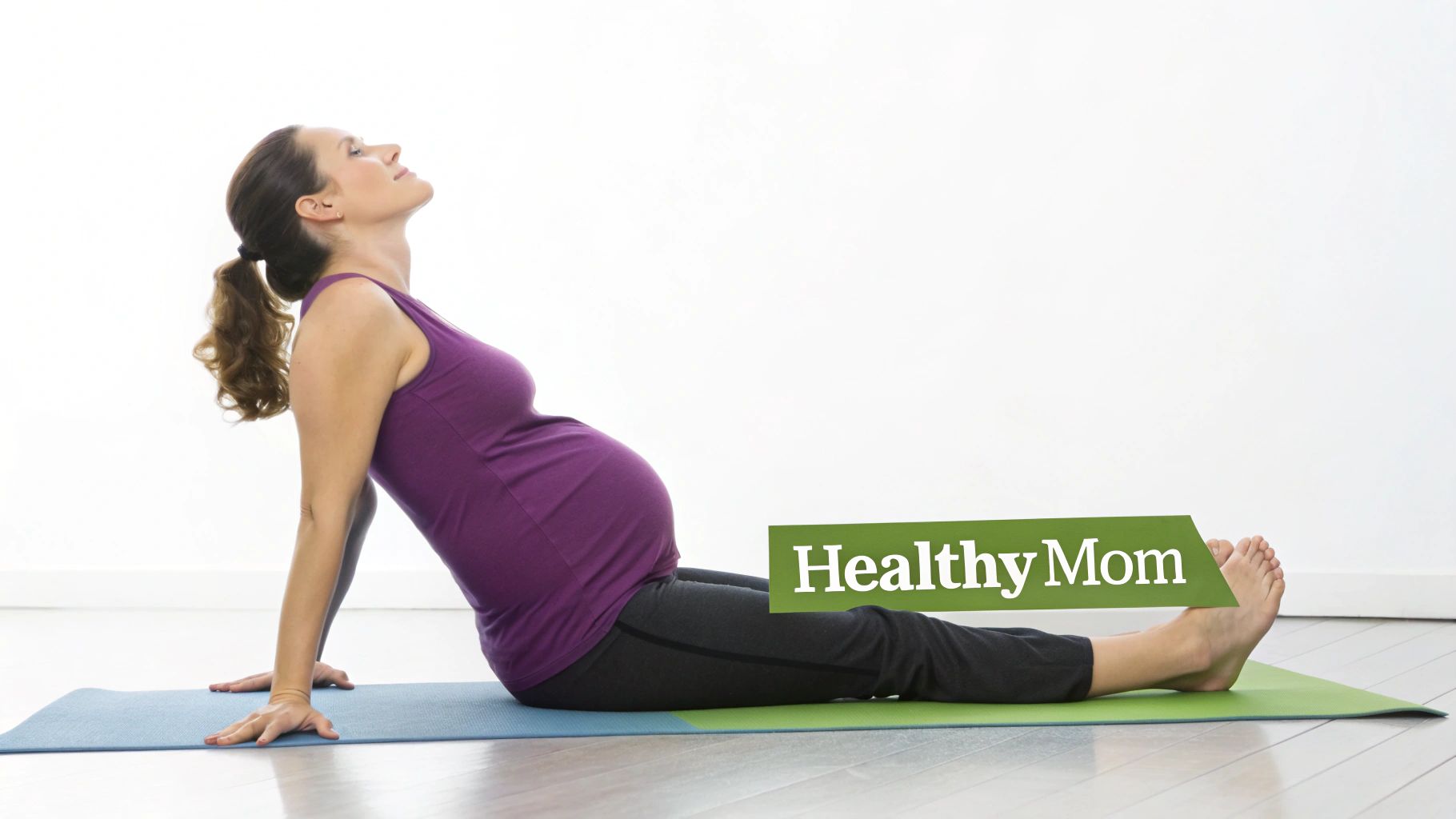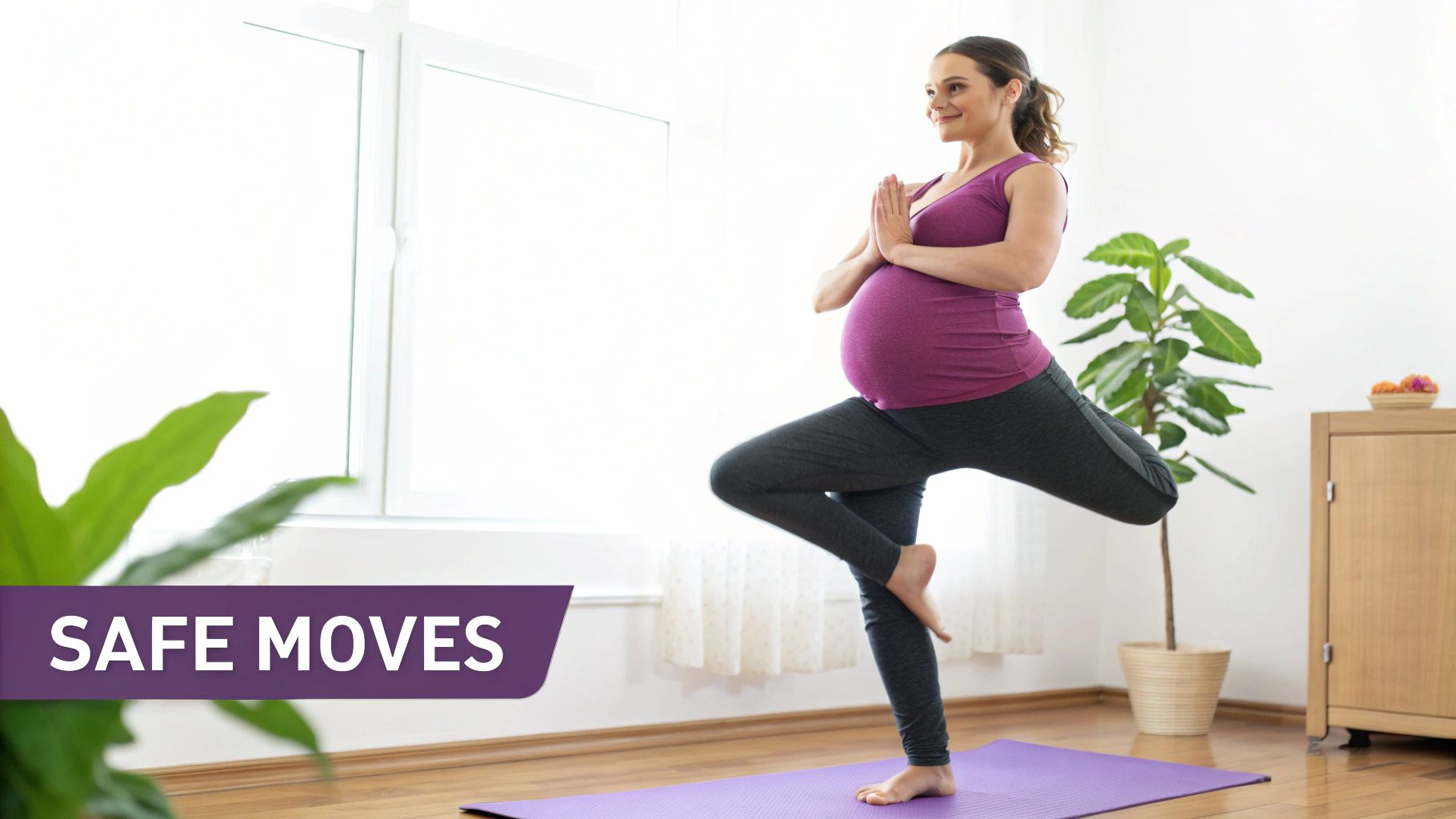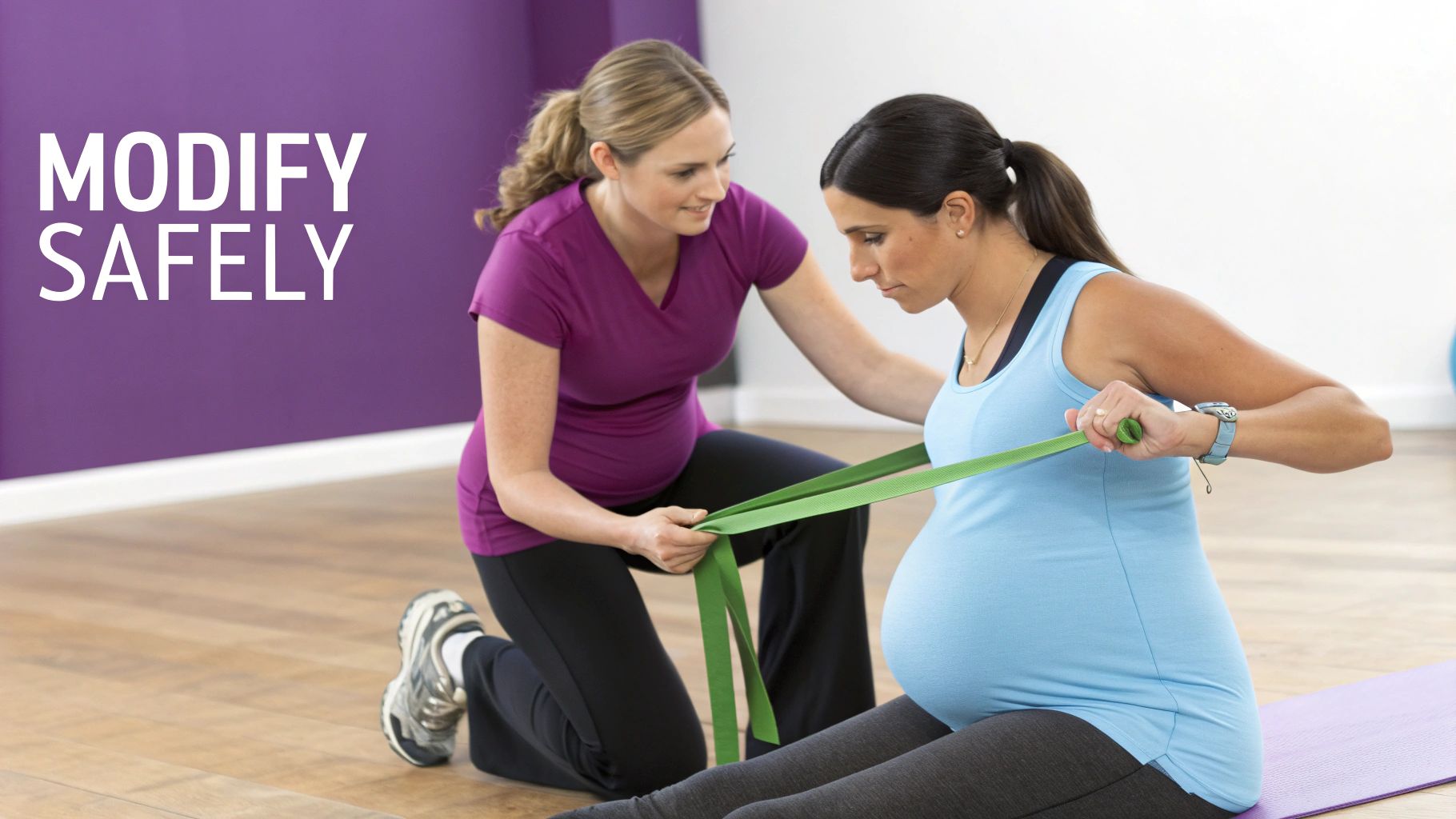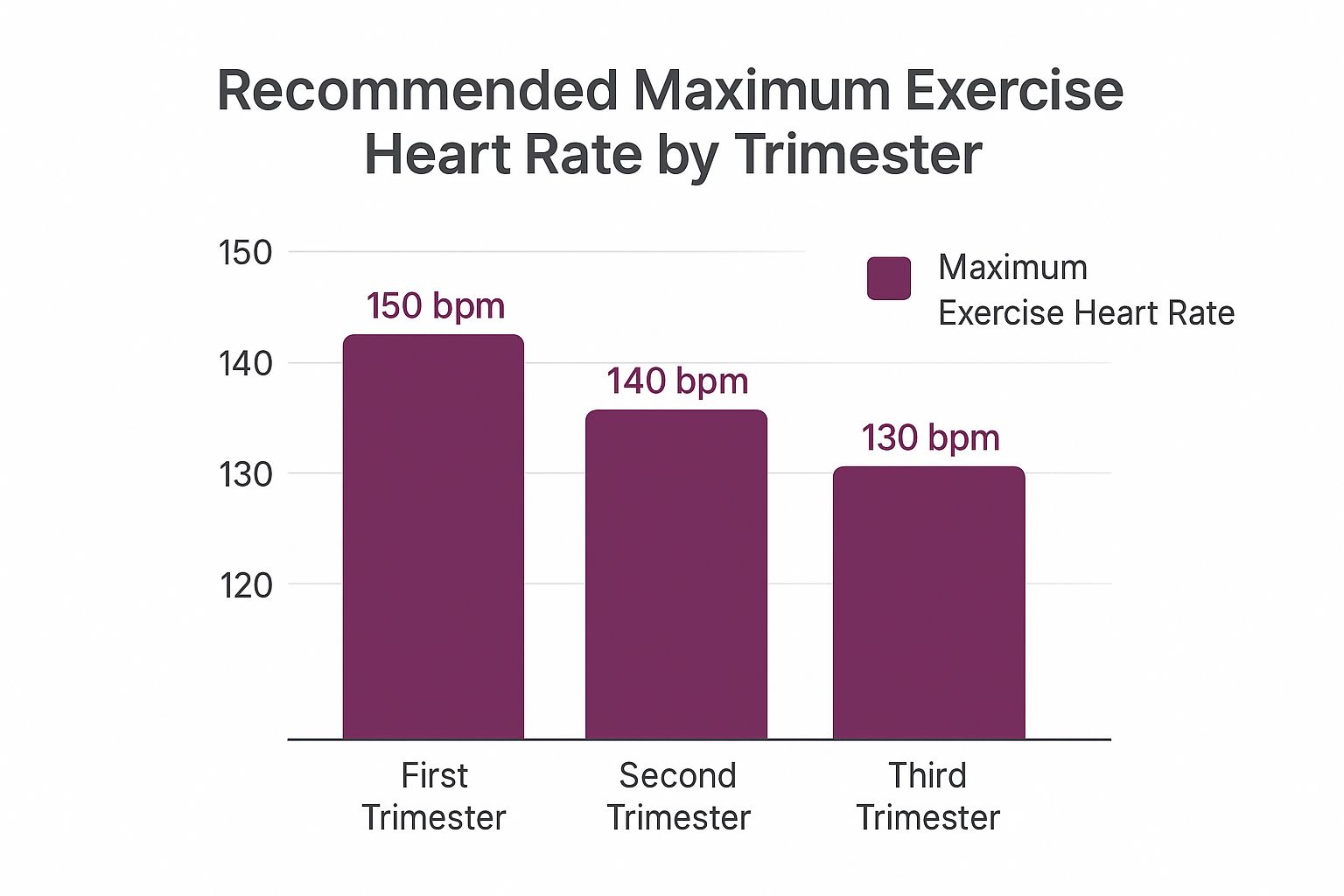
How to Exercise During Pregnancy: A Practical Guide
When figuring out how to exercise during pregnancy, the best advice is simple: listen to your body.
For most healthy pregnancies, moderate, consistent movement is one of the best things you can do for yourself and your baby. It's not just safe; it’s highly recommended.
Think of it as preparing your body for labor while helping you feel better day-to-day. A combination of gentle exercise and a balanced diet will set you up for success.
The Foundation of Prenatal Fitness
Exercising while pregnant requires a shift in mindset. This isn't the time to chase new personal bests or push yourself to the limit.
Instead, your goal is to maintain strength, improve endurance, and support your changing body through safe and steady movement.

This approach is about building a foundation that will carry you through all three trimesters and set you up for a smoother postpartum recovery. It’s about tuning into your body's signals.
Why Movement Matters
Staying active during these nine months offers benefits that go beyond the physical. It’s a powerful tool for your mental and emotional well-being, too.
So, what are we talking about?
- Reduced Discomfort: Gentle, regular movement is fantastic for easing common pregnancy complaints like backaches, bloating, and swelling.
- Improved Mood and Energy: A good workout is a natural mood-booster and can be a secret weapon against pregnancy fatigue.
- Preparation for Labor: Building stamina and strengthening key muscles—like your core and pelvic floor—can make a real difference when it comes time for delivery.
- Better Sleep: Many women find that moderate activity during the day helps them rest more soundly at night.
One of the biggest myths is that pregnancy requires you to be delicate and sedentary. The opposite is true: an active pregnancy is often a more comfortable one. The secret is knowing how to adapt your routine, not abandon it.
To help you get started, here's a quick summary of the core principles.
Quick Guide to Prenatal Fitness Dos and Don'ts
| Do | Don't |
|---|---|
| Check with your doctor first. Always get their green light before starting or changing your routine. | Push through pain. Discomfort is a signal from your body to stop and reassess. |
| Stay well-hydrated. Drink plenty of water before, during, and after your workout. | Overheat. Avoid hot yoga or exercising in extreme heat, which can be dangerous. |
| Focus on your core and pelvic floor. These muscles are crucial for support and recovery. | Lie flat on your back for long periods (especially after the first trimester). |
| Listen to your body. Rest when you feel tired and modify exercises as your body changes. | Engage in high-impact or high-risk sports. Now is not the time for contact sports or activities with a high risk of falling. |
This table is a starting point. Keeping these fundamentals in mind will help ensure your fitness journey is both safe and effective.
Global Recommendations for an Active Pregnancy
This isn't just an opinion; it’s backed by a solid global consensus. Health organizations worldwide recommend that pregnant women (without complications) aim for 150 to 300 minutes per week of moderate-intensity aerobic activity.
This guidance comes from leading experts. To dive into the specifics, you can read the full research about these international recommendations.
If you’re new to working out, don't be intimidated! Starting with something simple is the best approach. Our guide on workout routines for beginners at home has great ideas you can adapt, once you get your doctor’s approval.
Start slow and build up gradually.
First Trimester Fitness: Working With Your Body
The first trimester can be a rollercoaster of excitement, exhaustion, and morning sickness. A workout might be the last thing on your mind.
But gentle movement can be your best friend. It can often ease nausea and give you a much-needed energy boost.

Redefine what a "workout" means right now. It’s not about pushing limits. It’s about listening to your body, finding what feels good, and gently building a foundation for the months ahead.
Embrace Low-Impact Movement
Your body is doing something incredible, which takes a massive amount of energy. That's why fatigue is so common.
Low-impact exercise shines here; it gets your blood pumping without draining your battery.
Here are a few great options to get started:
- Brisk Walking: Never underestimate the power of a 20-30 minute walk. Fresh air can do wonders for your mood and queasiness.
- Swimming or Water Aerobics: The pool feels amazing. Water’s buoyancy supports your changing body and takes pressure off your joints.
- Prenatal Yoga: This is designed for pregnancy, focusing on breathing, stability, and strengthening your pelvic floor.
If you're at home, you can still get some light movement in. For easy-to-follow ideas, this DietExercise YouTube channel video demonstrates simple moves perfect for this stage.
Working Around Nausea and Fatigue
When dealing with morning sickness, when you exercise can be as important as what you do. Many women find a mid-morning walk after a small snack is the sweet spot.
The most important rule of first-trimester fitness is to listen to your body’s new signals. If you're completely drained, a nap might be more beneficial than a workout. Don't feel guilty for resting—it's productive.
Pairing movement with smart nutrition makes a huge difference. Keep small, bland snacks handy—like crackers or almonds—to nibble on before you get moving. And hydrate all day long!
Sometimes, feeling comfortable is half the battle. A soft, breathable Diet and Exercise T-shirt can make you feel less restricted and more motivated. Create habits that make you feel good, inside and out.
Second Trimester Workouts: Finding Your Stride
Welcome to the second trimester! For many, this is the "golden" period of pregnancy. The fog of fatigue often lifts, leaving you with a surge of energy.
As your body changes, your fitness approach must adapt. Your growing belly shifts your center of gravity, making balance and stability more important than ever.
The goal now is supporting your body, maintaining strength, and feeling good.

Staying active during pregnancy can be tough. A review of 44 studies found that in about 59.09% of cases, pregnant women got low levels of physical activity. This happens even though we know movement is great for mom and baby. If you're curious, you can discover more insights about prenatal fitness studies.
Adapting Your Routine for a Growing Belly
With renewed energy, you might be tempted to jump back into intense workouts. But it's crucial to make smart modifications for safety and comfort.
Focus on supporting your body's new alignment and avoiding strain on your core and back.
The biggest rule change? Stop doing exercises that have you lying flat on your back. The weight of your uterus can press on a major vein (the vena cava), reducing blood flow.
Instead of lying flat for exercises, prop yourself up with pillows or use an incline bench. It's a simple tweak to keep strength training safely.
Smart and Safe Second Trimester Exercises
Now that you have your energy back, choose movements that strengthen and support your body without causing strain.
Here are a few excellent options:
- Modified Strength Training: Stick with compound movements like squats and lunges. They’re fantastic for strengthening your legs, glutes, and core. Use lighter weights than you did pre-pregnancy.
- Stationary Cycling: This is a brilliant low-impact cardio choice. You’ll get your heart rate up without jarring your joints, and there's zero risk of falling.
- Swimming: The feeling of weightlessness in water can be a huge relief for an aching back and swollen joints. It’s a full-body workout with no impact.
A great rule of thumb is the "talk test." You should always be able to hold a conversation while exercising. If you're too breathless to chat, ease up.
Supporting Your Core and Pelvic Floor
As your belly grows, you’ll probably feel more strain on your lower back. Extra support during workouts can make a massive difference.
Using a Prenatal Support Band can help lift your abdomen, taking pressure off your back and pelvis. The gentle compression makes moving around feel much more comfortable.
This is also a key time to focus on your deep core and pelvic floor muscles. They are your body’s internal support system.
- Pelvic Tilts: Do these on your hands and knees (like a cat-cow pose) to gently work your abdominal muscles and ease back tension.
- Kegels: Keep up with daily Kegels! They strengthen the muscles supporting your bladder, uterus, and bowels, which is vital for labor and postpartum recovery.
Pair these exercises with smart eating habits—like small, frequent meals packed with protein and complex carbs—for optimal fuel. For more simple home routines, check out the DietExercise YouTube channel.
Third Trimester: Gearing Up for Labor
As you enter the final stretch, your fitness goals shift. It's less about building strength and more about prepping your body for labor and delivery.
Your exercise routine should support your body, not push it to its limits.
Lean into gentle, purposeful movements. Think of every stretch and squat as a way to prepare for the big day. Consistency over intensity is key.
Easing Aches and Opening Hips
Lower back and hip pain are common in the third trimester, thanks to your growing belly and loosening ligaments.
The right movement can bring relief and help prepare your pelvis for childbirth. A birthing ball is your new best friend.
Sitting on one can improve your posture and take pressure off your back. I recommend gentle hip circles and figure-eights on the ball. This is a low-impact way to open your hips and encourage the baby into an ideal birth position. The DietExercise YouTube channel has easy-to-follow visual routines.
Keeping your workouts safe means monitoring your intensity.

As you can see, the recommended heart rate tapers off as you get further along, landing around 130 bpm in the third trimester. This is a reminder to scale back and focus on steady, controlled movements.
Building Stamina for Labor and Beyond
Pelvic floor exercises are crucial right now. A strong pelvic floor supports your growing baby, helps during delivery, and makes for a smoother postpartum recovery. Daily Kegels are non-negotiable!
Bodyweight squats are another powerhouse exercise. They strengthen your glutes and legs—muscles you'll lean on during labor—and help open the pelvis.
If you feel unstable, supportive leggings can make a difference. Our Maternity Leggings are designed with gentle compression to support your bump, helping you feel more confident.
Listening to your body is more important now than ever. If an exercise causes pain, dizziness, or just feels wrong, stop. Your body is sending clear signals.
This commitment to gentle activity can impact your delivery. A review of 16 studies found that physical activity during pregnancy increases the chance of a normal vaginal delivery by about 14%. It also helped reduce the rate of C-sections by 34%. You can learn more about these exercise findings and dig into the specifics.
Don’t forget to pair these exercises with a nutrient-rich diet. Focus on getting enough iron to combat fatigue and fiber to keep things moving. This balanced approach helps you feel your best.
Exercise Modifications by Trimester
As your body changes, your workouts need to change, too. This table gives you a quick look at how to adapt common exercises as your pregnancy progresses.
| Exercise | First Trimester | Second Trimester | Third Trimester |
|---|---|---|---|
| Squats | Full range of motion. Can add light weights if you feel comfortable. | Widen your stance for stability. Focus on bodyweight or very light weights. | Reduce depth to a comfortable level. Hold onto a chair or wall for support. |
| Plank | Standard plank on toes or knees is generally fine. | Modify to an incline plank (hands on a bench) or a kneeling plank. Avoid coning. | Focus on standing core work or "cat-cow" stretches. Avoid traditional planks. |
| Walking/Jogging | Continue your usual routine, monitoring for fatigue. | May need to switch from jogging to power walking. Focus on even surfaces. | Gentle walking is best. Listen to your body and watch for pelvic pressure. |
| Push-ups | Can be done on toes or knees. | Transition to wall push-ups or incline push-ups to reduce core strain. | Stick to wall push-ups to protect your core and back. |
Remember, these are just guidelines. The most important thing is to listen to your body and do what feels right for you and your baby.
Knowing When to Stop: Essential Safety Signs
When you're exercising for two, listening to your body is your most important job. While staying active is fantastic, safety always comes first.
Think of it as your body giving you constant feedback. You just need to interpret the signals.
This isn't about being scared to move. It’s about being smart and in control. Knowing the non-negotiable safety signs lets you approach workouts with confidence.
Red Flag Warning Signs
If you experience any of the following symptoms, stop what you're doing immediately and contact your doctor or midwife. Do not push through these.
- Vaginal bleeding or any leaking fluid: This is an immediate call-your-doctor situation.
- Dizziness, lightheadedness, or feeling faint: This could be a sign of low blood pressure or overexertion.
- Chest pain or heart palpitations: Actual pain is never a normal sign.
- A sudden, severe headache: This could signal something more serious and needs to be checked out.
- Pain or swelling in your calf: This can be a sign of a blood clot and requires prompt medical attention.
Staying Safe During Every Workout
Beyond those red flags, a few daily habits are crucial. Hydration is at the top of the list. Sip water consistently all day long.
Overheating is another real risk. Your core body temperature is already higher during pregnancy, so skip hot yoga or exercising on scorching days. Opt for light, breathable clothing.
Remember, the goal of pregnancy exercise is maintenance, not setting personal records. You’re building strength for a healthy delivery and a smoother recovery.
Finally, some activities are off the table for now. Avoid contact sports, anything with a high risk of falling (like skiing or horseback riding), and scuba diving. A hard fall is a risk you don't want to take.
Pairing this awareness with smart nutrition is the other half of the equation. Understanding how a calorie deficit can be incredibly helpful will help you fuel your body effectively for both your workouts and your baby's development.
Your Pregnancy Exercise Questions Answered
Figuring out how to move your body safely during pregnancy can feel overwhelming. Let's walk through some common concerns so you can feel confident in your fitness routine.
How Soon Can I Exercise After Finding Out I Am Pregnant?
If you already had a consistent workout routine, you can generally keep it up with a few smart modifications. First, chat with your doctor or midwife. They can give you personalized advice.
If you're new to exercise, pregnancy is a great time to start building healthy habits. Start small with something like a daily 15-20 minute walk. It's all about gentle consistency.
What Are The Best Exercises To Strengthen The Pelvic Floor?
Kegels are the gold standard. To do them right, picture yourself trying to stop the flow of urine mid-stream. Squeeze those muscles, hold for a few seconds, then release completely.
Aim for three sets of 10-15 repetitions throughout your day. You can also incorporate bodyweight squats and glute bridges to strengthen the entire pelvic girdle.
A strong pelvic floor is like building a supportive hammock for your baby. Consistent strengthening now pays huge dividends during labor and helps your body heal more easily afterward.
Are There Any Exercises I Must Absolutely Avoid?
Yes, definitely. For your safety, some activities are off-limits. Steer clear of contact sports (like soccer) and anything with a high risk of falling (like skiing or horseback riding).
After the first trimester, avoid exercises that have you lying flat on your back for long periods. Also, avoid working out in extreme heat or humidity to prevent overheating.
How Do I Know If I Am Exercising Too Hard?
The "talk test" is your most reliable tool. You should always be able to carry on a conversation while moving. If you're too out of breath to speak comfortably, pull back a bit.
Remember, pregnancy is about maintaining health, not pushing for personal records. Listen to your body's signals. For visual examples of different exercises, the DietExercise YouTube channel is a fantastic resource.
At Diet and Exercise, we believe in supporting your health journey every step of the way. Explore our collection of comfortable fitness apparel and accessories to make your prenatal workouts even better. Visit us today at https://dietexerciseshop.com.
